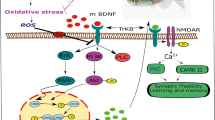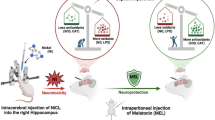Abstract
Epilepsy is a disorder characterized by recurrent seizures, which can increase the content of reactive oxygen in the brain. Active oxygen free radical scavengers such as ascorbic acid or α-tocopherol (vitamin E) might prevent epilepsy. A variety of animal seizure models exist which help to document the effects of vitamin E and specify its action. In this study, we have evaluated dose-dependent effect of α-tocopherol on penicillin-induced epileptiform activity, analyzed by electrocorticogram (ECoG). The epileptiform activity was induced by microinjection of penicillin into the left sensorimotor cortex. Thirty minutes after penicillin injection, 100, 300, or 500 mg/kg of α-tocopherol was administrated intramuscularly (i.m.). α-Tocopherol (100, 300, or 500 mg/kg) alone did not significantly change the spike amplitudes in non-penicillin pretreated control animals. α-Tocopherol of 300, or 500 mg/kg significantly decreased the frequency of epileptiform activity in the penicillin-pretreated animals. The low dose of α-tocopherol (100 mg/kg) did not significantly change either amplitude or frequency of epileptiform activity. α-Tocopherol of 500 mg/kg i.m. was the most effective dose in changing of frequency on penicillin-induced epileptiform activity. The anti-convulsant effects of α-tocopherol appeared 80, 60, 30 min after α-tocopherol injection in 300, 500, and 3 day vitamin E supplemented groups. These data indicate that α-tocopherol decreases the frequency of penicillin-induced epileptic activity.


Similar content being viewed by others
References
Avanzini G, Franceschetti S (2003) Cellular biology of epileptogenesis. Lancet 2:33–42
Ayyildiz M, Yildirim M, Agar E, Baltaci AK (2006) The effect of leptin on penicillin-induced epileptiform activity in rats. Brain Res Bull 68:374–378
Drevon CA (1991) Absorption, transport and metabolism of vitamin E. Free Radic Res Commun 14:229–246
Frantseva MV, Velazquez JLP, Tsoraklidis G, Mendonca AJ, Adamchik Y, Mills LR, Carlen PL, Burnham MW (2000) Oxidative stress is involved in seizure-induced neurodegeneration in the kindling model of epilepsy. Neuroscience 97:431–435
Godlevskii LS, Stepanenko KI, Lobasyuk BA, Sarakhan EV, Bobkova LM (2004) The effects of electrical stimulation of the paleocerebellar cortex on penicillin-induced convulsive activity in rats. Neurosci Behav Physiol 34:797–802
Halliwell B, Gutteridge JMC (1990) The antioxidants of human extracellular fluids. Arch Biochem Biophys 280:1–8
Horwitt MK (1979) The vitamins: vitamin E. In: Goodhart RS, Shils ME (eds) Modern nutrition in health and disease. Lea and Febirger, Philadelphia
Jerrett SA, Jefferson D, Mengel CE (1973) Seizure H2O2 and lipid peroxidase in brain during exposure to oxygen under high pressure. Aeroesp Med 44:40–44
Kabuto H, Yokoi I, Ogawa N (1998) Melatonin inhibits iron-induced epileptic discharges in rats by suppressing peroxidation. Epilepsia 30:237–243
Kovacs R, Schucmann S, Gabriel S, Kann O, Kardos J, Heinemnn U (2002) Free radical-mediated cell damage after experimental status epilepticus in hippocampal slice cultures. J Neurophysiol 88:2909–2918
Koteghawa M, Sugiyama M, Shoji T, Haramaki N, Ogura R (1993) Effect of α-tocopherol on high energy phosphate metabolite levels in rat heart by P-NMR using a Langendoff perfusion technique. J Mol Cell Cardiol 25:1067–1074
Kryzhanovskii GN, Nikushkin EV, Braslavskii VE, Glebov RN (1980) Lipoperoxidation in the hyperactive focus of rat cerebral cortex. Biull Eksp Biol Med 89:14–16
Levy Sl, Burnham WM, Bishai A, Hwang PA (1990) An evaluation of the anticonvulsant effects of vitamin E. Epilepsy Res 6:12–17
Levy Sl, Burnham WM, Bishai A, Hwang PA (1992) The anticonvulsant effects of vitamin E: a further evaluation. Can J Neurol Sci 19:201–203
Marangoz C, Ayyildiz M, Agar E (1994) Evidence that sodium nitroprusside possesses anticonvulsant effects mediated through nitric oxide. Neuroreport 5:2454–2456
Ogunmekan AO (1985) Plasma vitamin E levels in apparently normal children with and without anticonvulsant drug therapy. Trop Geogr Med 37:175–1777
Ogunmekan AO, Hwang PA (1989) A randomized, double-blind, placebo-controlled, clinical trial of D α-tocopheryl acetate (vitamin E), as add-on therapy, for epilepsy in children. Epilepsia 30:84–89
Oliver CN, Starke-Reed PE, Stadtman ER, Lin GJ, Correy JM, Floyd RA (1990) Oxidative damage to brain proteins, loss of glutamine synthetase activity and production of free radicals during ischemia/reperfusion induced injury to gerbil brain. Proc Natl Acad Sci USA 87:5144–5147
Rauca C, Wiswedel I, Zerbe R, Keilhoff G, Krug M (2004) The role of superoxide dismutase and α-tocopherol in the development of seizures and kindling induced by pentylenetetrazol-influence of the radical scavenger α-phenyl-N-tert-buthyl nitrone. Brain Res 109:203–212
Ribeiro MCP, Avila DS de, Schneider CYM, Hermes FS, Furian AF, Oliveira MS, Rubin MA, Lehmann M, Kreiglstein J, Mello CF (2005) Α-Tocopherol protects against pentylenetetrazol-and methylmalonate-induced convulsions. Epilepsy Res 66:185–194
Sridharan R (2002) Epidemiology of epilepsy. Curr Sci 82:664–670
Steffens M, Huppertz HJ, Zentner J, Chauzit E, Feuerstein TJ (2005) Unchanged glutamine synthetase activity and increased NMDA receptor density in epileptic human neocortex: implications for the pathophysiology of epilepsy. Neurochem Int 47:379–384
Sudha K, Ashalatha VR, Rao A (2001) Oxidative stress and antioxidants in epilepsy. Clin Chimica Acta 303:19–24
Tucker JM, Townsend DM (2005) Alpha-tocopherol:roles in prevention and therapy of human disease. Biomed Pharmacother 59:380–387
Vatassery GT, Adityanjee, Quach HT, Smith WE, Kuskowski MA, Melnyk D (2004) Alpha and gamma tocopherols in cerebrospinal fluid and serum from older male, human subjects. J Am Coll Nutr 23(3):233–238
Willmore LJ, Rubin JJ (1981) Antioxidant pretreatment and iron-induced epileptiform discharges in the rat: EEG and histopathologic studies. Neurology 31:63–69
Author information
Authors and Affiliations
Corresponding author
Rights and permissions
About this article
Cite this article
Ayyıldız, M., Yıldırım, M. & Agar, E. The effects of vitamin E on penicillin-induced epileptiform activity in rats. Exp Brain Res 174, 109–113 (2006). https://doi.org/10.1007/s00221-006-0425-7
Received:
Accepted:
Published:
Issue Date:
DOI: https://doi.org/10.1007/s00221-006-0425-7




